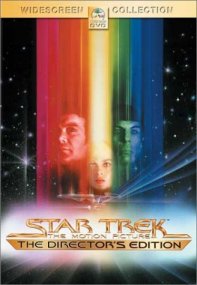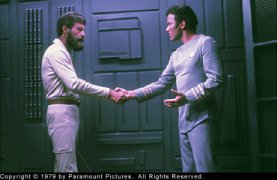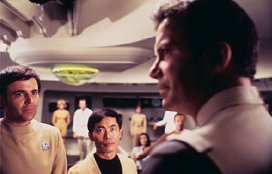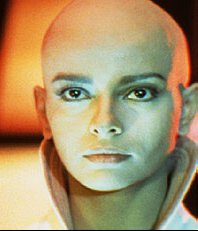|
Star Trek: The Motion Picture
Star Trek: The Motion Picture
Release Date: November 6, 2001
Run Time: approximately 136 Earth minutes
Ten-second Rundown: Kirk gathers his crew and assumes command of the newly refitted Enterprise and thus angers her new captain, in an attempt to defend Earth against a giant electric cloud.
Version: The Director's Edition
Extras:
Group commentary by director Robert Wise, special photographic effects director Douglas Trumbull, special photographic effects supervisor John Dykstra, music composer Jerry Goldsmith and actor Stephen Collins Text Commentary by Michael Okuda, co-author ofThe Star Trek Encylopedia New retrospective documentaries with cast and crew interviews 3 trailers 8 TV Commercials (from 1979) 5 Additional Scenes (from the 1979 theatrical version) 11 Deleted Scenes (from the 1983 TV version - taken out for time) Storyboard Archives New Star Trek Series Enterprise Promo Spot Technical Specifications:
Widescreen Anamorphic transfer (1.85:1), English Dolby Digital 5.1, Dolby Surround 2.0, and English subtitles.
Star Trek: The Motion Picture is one of those movies that can't be forgotten. Not because it was great, but because the studio won't let us. The Director's Version makes the fourth incarnation ST:TMP has gone through. Each time it has shown up there has been some alteration to make it better or more interesting. Finally, we get director Robert Wise's "original vision."
During the production of the movie a lot of elements included in the script didn't make it to the big screen. Time just ran out to make all the special effects come together. According to the documentaries included on the DVD, time was so tight Wise carried the final cut of The Motion Picture with him on the plane to opening night. Twenty years later he used this excuse (and the release of all Star Trek films to DVD) to finish what he had started.
So don't be expecting something like the Star Wars special edition. Wise didn't want to go through and add in Jabba the Hutts, or any other new special effects that hadn't been possible and conceived of in 1978.
All the new digital shots happen in the first 10 minutes of the film, save for a few external shots of the new Enterprise confronting V'Ger - the giant electric cloud. The new shots are all based on the original storyboards. We now see a much more realistic 23rd century San Francisco. On Vulcan the continuity has been fixed between Spock and the rest of the set. They even went so far as to draw in a CGI Nimoy walking along a new digital Vulcan inhabited by 50 feet high statues.
The original Enterprise model used in the film was stored somewhere in the Paramount lot and dug up for the digital artists to use as a reference. This was a great help. The new external shots of the ship look fantastic. And now the different things V'Ger throws at the Enterprise (like balls of lighting and electric webs) are better depicted.
But there still is something to be said about the Enterprise being an actual model. In comparison, it is very easy to tell which is a real object and which is a drawing. But since neither actually are acre-wide star ships you can take your pick.
The film is still slow - slower actually. Wise included a lot of shots that were cut due to time. Now there are longer talking scenes in the middle of battles, and much much much longer scenes with music and reaction shots. Dull.
It's easy to get lost in the story. There are so many side elements: the love story between Decker and Ilia, Kirk's struggle for command, Spock's hunger for logic. It's almost like a mini-series. Which is fitting since Star Trek: The Motion Picture was originally conceived as a TV pilot. Michael Eisner - who at the time was head of Paramount - heard the final pitch for the new Star Trek series, Phase II, and changed the direction of the project. This might have a big mistake. It could have flown high as a TV pilot. Instead, it stayed on the ground as a B picture.
Little-known Trek lore: the film did so poorly that Gene Roddenberry, father of Star Trek, was not allowed to return with such heavy involvement for the next film(s). So instead he pitched The Next Generation.
And look at the differences. Both were set on the Enterprise. Kirk's number one executive officer was named Decker - Picard called Riker "number one." Decker was in love with Ilia the sexy Deltan - Riker was in love with Troi the sexy Betazoid. That Gene was just full of new ideas. Even the series titles sounded nothing alike: Phase II versus The Next Generation. Wow.
The extras on this two disc set are overwhelming. And redundant. You can watch the film with the director's commentary (which is hard to hear - Wise mumbles a lot), then play one of the documentaries and hear the same things. They almost sound like direct dubs, as if they just pulled sound bites straight from the interviews in the documentaries and passed them off as commentary.
Okuda's technical commentary, however, is very informative and at times rather funny. But since the side notes flash far too fast on the bottom of the screen, it's hard to keep up with the tempo of reading then watching, then reading, then watching. And worst of all, at times he writes repetitive information. How many times do we need to learn how the shots were made on Vulcan?
If you skip the commentaries and stick to the documentaries on disc two you won't run into any repeat info - and it will be more interesting. The three documentaries cover everything you'd ever want to know about The Motion Picture including the history of Phase II, the making of the original film and the making of the Director's Edition. And they are fun to watch.
They've also included all of the TV commercials used to promote the theatrical release in 1979. But they are all pretty much the same, with the same boring tag line: The Human Adventure Begins. However, if you watch carefully you'll notice that somewhere between 1979 and 2001 The Motion Picture was bumped up from a G rating to a PG. Perhaps it's Ilia's lingerie-like uniform supplied by V'Ger.
Remembering that the entire project is built on finishing what they imagined in '78, the most fascinating feature is the storyboards. These sketches where preserved from the first production and used to create all the added effects. Wise and crew did set out to do something very noble. In a time where everything is getting a special edition, with brand new effects, and never before seen scenes, it's nice to see the technology be used to simply finish what they started decades ago. Too bad they didn't choose a more interesting film.
Copyrights and trademarks for existing
entertainment (film, TV, comics, wrestling) properties are held by their
respective owners and are used with permission or for promotional purposes
of said properties. All other content ™ and © 2001 by FanboyPlanet.
If you want to quote us, let us know. We're media whores.
















